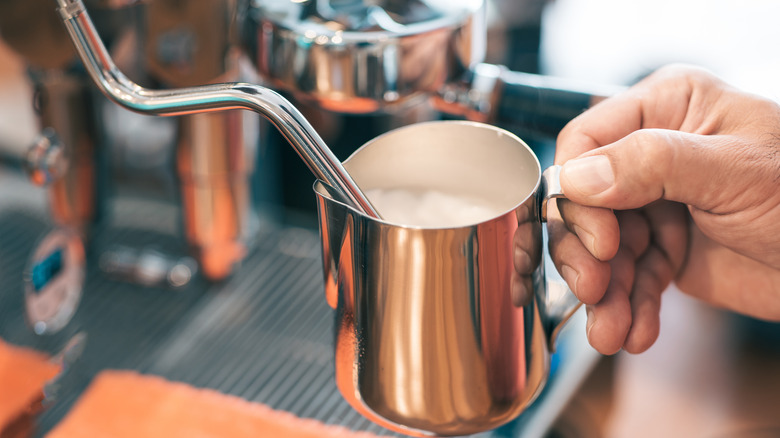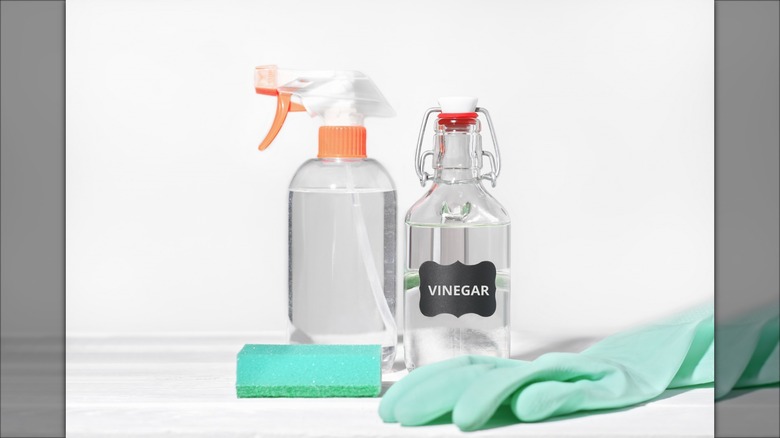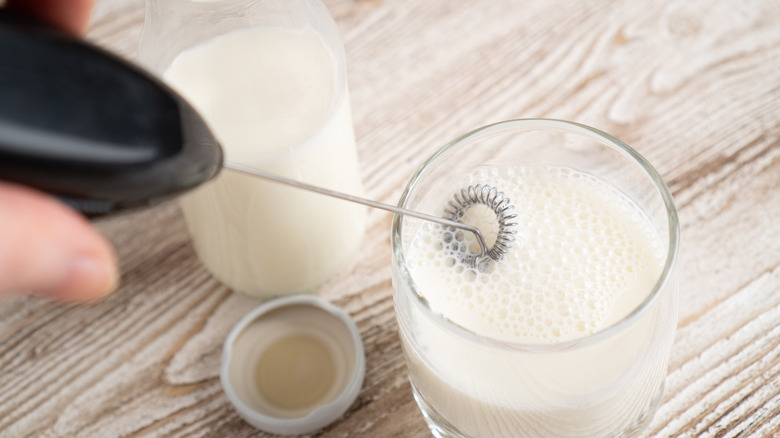Vinegar Is The Simple Secret To Cleaning Your Milk Frother
There's no denying that frothing up your favorite type of milk can level up your go-to coffee or espresso drink. While frothing milk is usually a super fun activity with tasty results, it can also be a messy endeavor. After you've created your stunning latte art and sipped and savored your caffeinated beverage, you're faced with the not-so-fun reality of having to clean your milk frother. If you wait too long, you may even have some dried-on foam to contend with. But before you start scrubbing away, consider giving yourself a helping hand by trying an easy vinegar hack.
According to Better Homes and Gardens, vinegar is a food-safe cleaning product that can help remove tough, caked-on gunk from kitchen appliances without all the extra chemicals found in many store-bought cleaners. By cleaning your frother with vinegar, you won't have to worry about potentially ingesting those yucky chemicals the next time you make a drink. It's a great way to save yourself some extra elbow grease and leave your beloved milk frother sparkling clean and ready to froth another day.
Acid in vinegar is key to cleaning
When cleaning your milk frother, you want a cleaning solution that's strong enough to break down the milk residue but not so strong that it corrodes the metal underneath. Additionally, because your milk frother comes in contact with something you ingest, you also want to use a non-toxic, food-safe cleaning product. "The important thing about vinegar is that it doesn't release fumes that can irritate your eyes and lungs and it is not toxic," Dr. Maria Vila, DO, medical advisor for eMediHealth shared with The Zoe Report.
The main thing that makes vinegar effective at cleaning your milk frother is that it contains about five percent acetic acid. Per the Harvard School of Public Health, vinegar's acidity makes it great at breaking down proteins, like milk proteins, which makes the milk particles easy to wipe away. One important tip to remember is that you'll want to dilute your vinegar with water so that it's not too strong, especially if you're going to be using it for routine cleaning. Additionally, according to Medical News Today, vinegar is safe to have in contact with your skin in diluted concentrations for short periods of time, but prolonged exposure can cause skin irritation. So, remember to wear gloves when cleaning with vinegar.
Avoid abrasiveness
Whether you have a built-in frothing wand on your espresso machine, a handheld frother, or a cup-style frothing device, most milk frothers are made of stainless steel. So it's important to make sure you don't scratch the stainless steel during cleaning — if you do, it can lead to rust forming on your milk frother. Some milk frothers also have a nonstick coating on top of the stainless steel which can be scratched off if it's scrubbed abrasively. So avoid scouring pads or steel wool when cleaning nonstick and stainless steel appliances like milk frothers. A microfiber cleaning cloth or a non-abrasive sponge are the best companions to your vinegar and water cleaning solution.
For a quick clean after each use, just spray with the vinegar-water solution and wipe away the milk residue. When deep-cleaning your milk frother, first remove as many parts as you can and soak them in vinegar and water for at least 30 minutes. Then, make sure you rinse the soaked parts thoroughly in the sink. Once you're sure that no vinegar is lingering on them, dry the parts off with a towel. Any non-removable parts can be sprayed with a mixture of vinegar and water and wiped gently with your sponge or cloth before you replace the rest. Then your frother is all clean and ready for your next latte.


